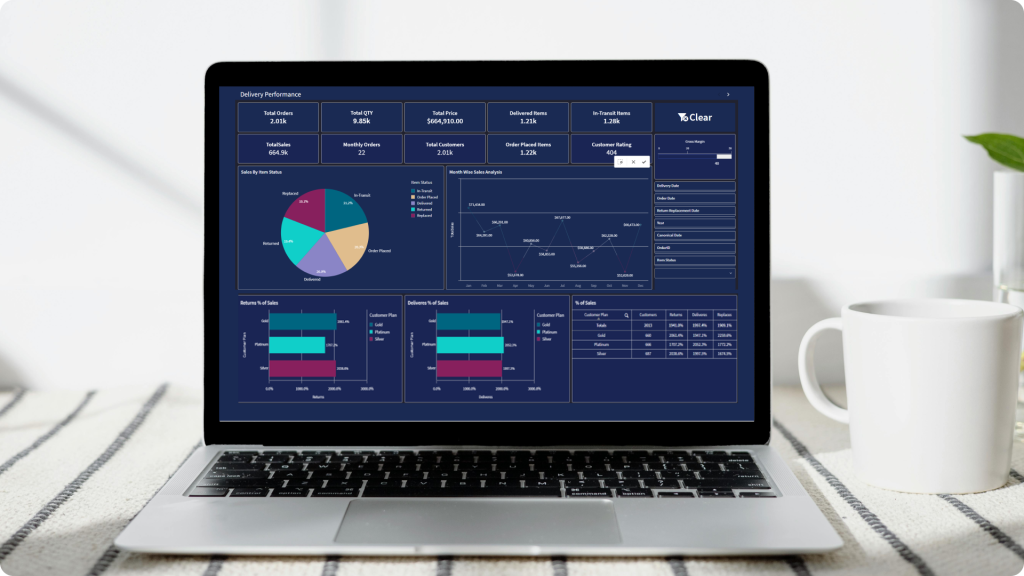In the era of data-driven decision-making, dashboards have become indispensable tools across departments, roles, and organizations. But a question our clients often ask is: Should we build a single, centralized dashboard—or break it down into multiple dashboards for different needs?
At Epicforce Tech, our consultants bring years of real-world experience helping companies structure their reporting architecture for clarity, performance, and strategic alignment. In this post, we’ll share our framework for determining the right approach, real-world use cases, and actionable advice to help you avoid common pitfalls.

Why the “One vs. Many” Dashboard Debate Matters
A dashboard is not just a report—it’s a lens into your business operations, tailored to empower decision-making at different levels. The way you structure your dashboards affects:
- Speed of insights
- Clarity and usability
- Security and data governance
- Stakeholder adoption
- Scalability
Get it wrong, and your teams may ignore dashboards altogether. Get it right, and your business moves faster and smarter.
When a Single Dashboard Makes Sense
Let’s start with the case for building one centralized dashboard.
1. Unified Business Goals
When your audience shares common KPIs—such as an executive team reviewing high-level performance metrics—a centralized dashboard promotes alignment and saves time.
Example: A CEO dashboard that combines sales, marketing performance, and customer churn into one high-level view.
2. Small Teams or Startups
If your team is lean and wears many hats, maintaining multiple dashboards can be overkill. One dashboard that highlights cross-functional metrics is often more effective.
3. Simpler Data Sources
If all your metrics are drawn from a single source like your CRM or ERP system, a unified dashboard reduces complexity.
4. Shared Access Requirements
If everyone viewing the dashboard should have access to all included data, there’s no need to segment based on permissions.
When to Build Multiple Dashboards
As teams scale or data becomes more nuanced, separating dashboards becomes not just beneficial—but necessary.
1. Distinct User Roles
Different departments (Sales, HR, Finance, Operations) need different metrics, visualizations, and filters. Tailored dashboards lead to better adoption and actionable insights.
Example: Your finance team needs detailed spend analysis, while the sales team needs deal pipeline tracking—two vastly different views.
2. Varying Data Sensitivities
Some data must be restricted due to compliance or business sensitivity (e.g., salary, legal risk). Separate dashboards ensure the right people see the right data.
3. Specific KPIs per Department
When each team has its own goals and performance indicators, cluttering one dashboard can confuse users. Purpose-built dashboards bring clarity and focus.
4. Performance Optimization
Too many widgets or filters can slow down dashboards. Multiple lightweight dashboards improve load times and user experience.
5. Storytelling and Flow
Some insights require a narrative flow (e.g., marketing funnel). Segmenting dashboards by funnel stage or initiative keeps messaging clear.

Our Proven Framework at Epicforce Tech
We use a three-phase approach to determine whether a client needs one dashboard or many:
Phase 1: Discovery and User Interviews
We start with understanding the end users:
- What decisions will this dashboard support?
- How often will they use it?
- What data access do they currently have?
Phase 2: KPI and Data Mapping
We identify overlapping and unique KPIs and assess their source systems and update frequency.
Phase 3: Access, UX, and Governance Design
We determine how to structure dashboards around permissions, data security, and ease of use, then map it to a scalable architecture.
This structured process ensures the dashboards are purpose-built, not just pretty charts on a page.
Real-World Examples: One vs. Many in Action
Case 1: One Dashboard for Cross-Functional Ops
A mid-size e-commerce company had fragmented reporting across logistics, support, and inventory. Epicforce Tech helped consolidate their core operations metrics into one unified dashboard for daily standups—boosting alignment and reducing meeting time by 30%.
Case 2: Many Dashboards for SaaS Client Success
A growing SaaS company needed separate dashboards for:
- Customer onboarding
- Product usage analytics
- Support ticket resolution
- Account health scoring
We implemented a modular reporting structure that enabled each team to work independently, with a master roll-up for executives.
Tools and Technologies We Recommend
We work with tools like Power BI, Tableau, Metabase, Looker, and Klipfolio, depending on your scale, budget, and tech stack. Each tool has strengths:
- Power BI for Microsoft ecosystems
- Looker for scalable embedded analytics
- Tableau for deep data storytelling
- Metabase for quick, no-code querying
More important than the tool is the thoughtful design—and that’s where Epicforce Tech comes in.
How to Decide: 5 Guiding Questions
Ask yourself:
- Who are the end users, and what decisions do they need to make?
- Are the data sources and KPIs shared or distinct across roles?
- What are the privacy or access control needs?
- How often will the data be viewed—and by whom?
- Do you need a scalable model that can grow with your business?
If your answers point to varied user needs, roles, and data access—multiple dashboards are likely the right call.

Final Thoughts: Design with Intent, Not Templates
Dashboards aren’t just about data—they’re about decision-making. Whether you’re building one dashboard or twenty, clarity, purpose, and simplicity must be your guiding principles.
At Epicforce Tech, we go beyond dashboards—we help you build systems that scale, drive alignment, and turn reporting into action. Our consultants don’t just ask what you want to see—they ask what you need to know.
Let’s Build Smart Dashboards—Together
Want help structuring your dashboards to drive better decisions and save time?
Contact Epicforce Tech today and get a free consultation with one of our dashboard architects. Whether you’re early in your reporting journey or need to optimize your current setup, we’ve got you covered.
(888) 280-5585
info@epicforcetech.com
Read More:
Epicforce Tech’s Dashboard Design Process: From Wireframe to Live Metrics
How Our Consultants Build Sales Dashboards That Actually Drive Revenue Conversations
How Epicforce Tech Integrates External Data Sources Into Epicor Dashboards
Epicforce Tech’s Step-by-Step Approach to Unlocking the Full Potential of Epicor Dashboards


